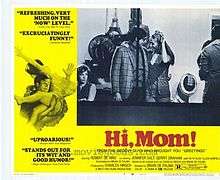Hi, Mom!
Hi, Mom! is a 1970 American black comedy film by Brian De Palma, and is one of Robert De Niro's first movies. De Niro reprises his role of Jon Rubin from Greetings (1968). In this film, Rubin is a fledgling "adult filmmaker" who has an idea to post cameras at his window and film his neighbors.[1][2][3][4][5][6]
| Hi, Mom! | |
|---|---|
 Theatrical poster | |
| Directed by | Brian De Palma |
| Produced by | Charles Hirsch |
| Written by | Brian De Palma Charles Hirsch |
| Starring | Robert De Niro Allen Garfield Jennifer Salt Lara Parker Paul Bartel Charles Durning Gerrit Graham |
| Music by | Eric Kaz |
| Cinematography | Robert Elfstrom |
| Edited by | Paul Hirsch |
Production company | West End Films |
| Distributed by | Sigma III Corp. |
Release date |
|
Running time | 87 minutes |
| Country | United States |
| Language | English |
Cast
- Robert De Niro as Jon Rubin
- Charles Durning as Superintendent
- Allen Garfield as Joe Banner
- Lara Parker as Jeannie Mitchell
- Bruce Price as Jimmy Mitchell
- Ricky Parker as Ricky Mitchell
- Andy Parker as Andy Mitchell
- Jennifer Salt as Judy Bishop
- Paul Bartel as Uncle Tom Wood
- Gerrit Graham as Gerrit Wood
- Floyd L. Peterson as John Winnicove
- Paul Hirsch as Avery Gunnz
- Joseph King as Dr Joe King
Be Black, Baby
The film's most memorable sequence involves a black radical group who invite a group of WASPs to feel what it is like to be black, in a sequence titled Be Black, Baby. The sequence is both a satire and an example of the experimental theatre and cinéma vérité movements. Shot in the style of a documentary film using a hand-held camera and grainy black and white film, it features a theater group of African American actors interviewing white-skinned Caucasians on the streets of New York City, asking them if they know what it is like to be black in the United States.
Later, a group of white theater patrons attend a performance by the troupe. First they are forced to eat soul food. The white audience is then subjected to wearing shoe polish on their faces, while the African American actors sport whiteface and terrorize the people in blackface. The white audience members attempt to escape from the building and are ambushed in the elevator by the troupe. As two of the black actors rape one of the white audience members, Robert De Niro arrives as an actor playing an NYPD policeman, and arrests members of the white audience under the pretense that they are black. The entire sequence plays with natural sound, is acted to appear unrehearsed, and apart from several cuts plays in "real time". De Palma's familiarity and collaboration with experimental theatre informs the sequence and exerts considerable emotional impact upon viewers, simultaneously engaging their personal responses to racism and commenting on the deceptive and manipulative power of cinema.
The sequence concludes with a thoroughly battered and abused audience raving about the show, showering praise on the black actors, crowing "Clive Barnes [New York Times theater critic] was right!"
MPAA rating board
According to the book The Movie Rating Game by Stephen Farber (Public Affairs Press, 1972), the film was originally given an "X" rating by the MPAA, but after a few minor trims, it was approved for an R. The main cut occurred during the scene where Gerrit Graham paints his entire body for the Be Black, Baby performance. He hesitated for a moment about painting his penis, and then finally finished the job. The actual painting of the penis was deleted to get the R. (The first film, Greetings, was released with an X after losing an appeal to change it to an R.)
Reception
Roger Greenspun of The New York Times wrote that the film "stands out for its wit, its ironic good humor, its multilevel sophistications, its technical ingenuity, its nervousness, and its very special ability to bring the sensibility of the suburbs to the sins of the inner city."[7] Variety stated that the film "is three-fourths of a funny, engaging serio-comedy about a 'peep art' filmmaker and urban guerrilla in New York. Unfortunately, the fourth that fails is the finale which literally and figuratively flops, leaving the audience with a creative promise unfulfilled."[8] Kevin Thomas of the Los Angeles Times wrote, "Satire is a naturally attractive form of expression for young film-makers, but few display the degree of sustained humor, energy and control that De Palma did in 'Greetings' and now even more so in the farther-ranging 'Hi, Mom!' Indeed, his ability to fuse hilarity and anger, spontaneity and discipline, is nothing short of brilliant."[9]
Additional notes
The movie introduced Jennifer Salt (after she made a cameo in Midnight Cowboy) and Charles Durning. Both actors later worked with DePalma on his suspense thriller Sisters. Appearing in a supporting role was Paul Bartel, who later moved from acting to directing. He directed films such as Eating Raoul and Scenes from the Class Struggle in Beverly Hills.
References
- "Hi, Mom! (1970)". amazon.com. Retrieved 17 January 2014.
- Lucia Bozzola, Rovi. "Hi, Mom! (1970)". nytimes.com. Retrieved 17 January 2014.
- "Hi, Mom! (1970)". rottentomatoes.com. Retrieved 17 January 2014.
- "Hi, Mom!". mubi.com. Retrieved 17 January 2014.
- Henderson, Eric. "Hi, Mom!". slantmagazine.com. Retrieved 17 January 2014.
- "Hi, Mom! (1970)". imdb.com. Retrieved 17 January 2014.
- Greenspun, Roger (April 28, 1970). "'Hi, Mom!' a Brian De Palma Satire". The New York Times. 50.
- "Film Reviews: Hi, Mom!" Variety. April 15, 1970. 17.
- Thomas, Kevin (June 25, 1970). "'Hi, Mom!' Topical Satire". Los Angeles Times. Part IV, p. 18.